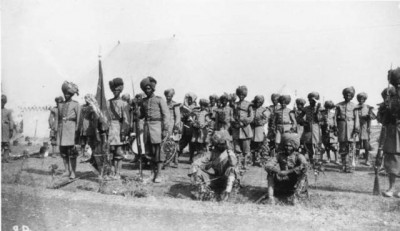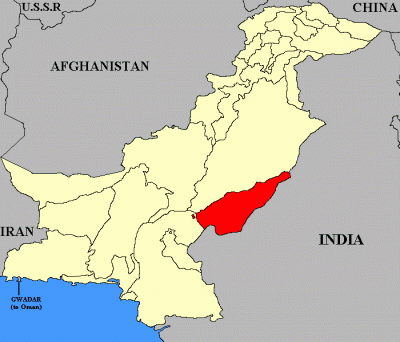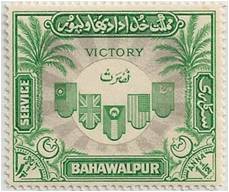ALBUM – View my Bahawalpur, Princely State of India album
Fast Facts
Region: India Area
Group: Indian Feudatory States
Classification: Semi-autonomous state
Prior Regime: Bahawalpur
Key Dates:
1802 – Bahawalpur state founded in 1802 by Nawab Mohammad Bahawal Khan Abbasi
1833, Feb 22 – Bahawalpur came under British suzerainty
1947. Oct 7 – Bahawalpur joined the newly formed Dominion of Pakistan
1955, Oct 14 – Bahawalpur merged into the province of West Pakistan
Following Regime: Bahawalpur, Princely State of Pakistan
Scott Catalogue: (Pakistan, Bahawalpur) #O1-O16
Pick Catalogue: none
Currency: 1 Rupee = 16 Annas = 64 Piece = 192 Pie
History

At the time of partition of India, all the princely states of the subcontinent were given a choice to join either Pakistan or India. The Nawab was wooed by India with various incentives, but in the end, Nawab Sadeq Mohammad Khan V signed an agreement on 5 Oct 1947 to become the first state to join Pakistan. The main factor was of course the shared Islamic beliefs (the majority in Bahawalpur State), and the close friendship the Nawab had with Quaid-i-Azam, the first leader of Pakistan.
 Nawab Sadeq Mohammad Khan V was very helpful and generous to the government of Pakistan. He gave seventy million rupees to the government and the salaries of all the government departments for one month drawn from the treasury of Bahawalpur state and he gifted his private property to the University of the Punjab, King Edward Medical College and the Mosque of Aitchison College in Lahore.
Nawab Sadeq Mohammad Khan V was very helpful and generous to the government of Pakistan. He gave seventy million rupees to the government and the salaries of all the government departments for one month drawn from the treasury of Bahawalpur state and he gifted his private property to the University of the Punjab, King Edward Medical College and the Mosque of Aitchison College in Lahore.
In 1953, the Nawab represented Pakistan at the installation of Faisal II of Iraq and at the coronation of Elizabeth II. In 1955, Nawab Sadiq Muhammad joined the province of West Pakistan, thus ending the offical role of the Nawab, although he received a year stipend and maintained the title of Nawab and protocol inside and outside Pakistan.
Stamps
 ALBUM
ALBUM
Until 1945, Bahawalpur used the postage stamps of British India, but the state began issuing official stamps on 1 Jan, 1945. The first set of stamps, inscribed in Urdu only, consisted of 6 beautiful pictorial scenes of Bahawalpur overprinted “sarkari” which means official. Later in 1945, three of the stamp designs issued were surcharged in black, and also had a black “sarkari” overprint. Before the partition, a total of 16 Official Stamps were issued in 1945 and 1946. There is also a set of 17 King George VI stamps if India overprinted BAHAWALPUR with a star and crescent, but the legitimacy of these stamps is disputed among experts.
After Bahawalpur decided to join the Dominion of Pakistan, it began issuing regular issue stamps on 1st December 1947.
All Bahawalpur stamps are of high quality, finely engraved, and quite beautiful, as it is known that the Nawab was a philatelist, and had a hand in designing the stamps. Bahawalpur stamps could only be used for delivery of mail within the state.
Banknotes
Bahawalpur used currency and Banknotes from British India.
Links
Bahawalpur from Wikipedia
Bahawalpur Stamp Catalogue from Pakistan Philately





Informative blog posted….
Bahawalpur was under the Punjab group of Princely states of under British rule. The stamps quality produced by the Nawab was of high quality printed by Thomas De La Rue London. After merger in to the Dominion of Pakistan it is now difficult to collect in India. I love to collect Bahawalpur stamps.
Hi readers and philatelists,
Just been surfing and found this site. I have been collecting Bahawalpur stamps for over 40 years and I see that some of your information is understandably inaccurate for such an obscure state.
For example the State had its own mint so produced its own coinage. It is debated when the State was first established but Amir Bahawal Khan Abbassi 1 ascended the throne in 1746 and in 1747 designed the walled capital city: Bahawalpur. (His descendants ruled until 1955.) The 1833 agreement was a trade agreement with the British East India Company and was mostly concerned about collecting taxes for goods passing through the State in exchange for military aid in the event of an attack by the neighbouring warlord Ranjit Singh.
The first stamp issued was a fiscal receipt stamp in 1876, followed by eight court fee stamps in 1880. Seven ordinary postage stamps and two with service overprints were issued in 1933 but withdrawn when not approved by the Indian Postal Agency. Permission was finally granted to commence from 1st Jan 1945 but the stamps were only released on 1st March.
The legitimacy of the Star and Crescent overprints was finally established when the last Amir’s archives were unsealed (after a 40 year of dispute over his estate) early this century.
Scott has always lagged behind on Bahawalpur so suggest that you refer to Stanley Gibbons or better still the 422 page book: The Amirate of Bahawalpur (Postal history & stamps 1932 -1949) by Isani and Hussain.
The unsealing also bought the Amir’s wonderful collection onto the market so you now have an opportunity to acquire some exceptional material.
All the best,
George
Hi George, Welcome to DCStamps.
It is nice to have experts in a particular area visit and make comments. I also understand your point about Scott catalogue’s limitations in various areas, but at the moment that is what I use currently. One of these days I will probably list the three major catalogue references (SG, Michel and Scott). Regarding the 1833 “start” date, I was referring to my understanding of when Bahawalpur came under British rule (as with all of my other India State histories). If you have a more precise date for when this happened, I would love to hear your expertise.
Thanks again
Michael
Hi,
Request for your valuable guidance on where to purchasing all the types of Stamps issued be Feudatory States, Convention States, Pre Independence and Post Independence India stamps for my personal collection. I am getting the images but I want the real stamps. [All stamps related to India]
Regards
Natasha
Great write-up as usual. Michael.
Bahawalpur tends to get neglected by collectors -at least by me!-as it is not listed under the India Feudatory States in the Scott Classic Specialized catalogue. Bahawalpur is strongly associated with Pakistan, so, perhaps, that is the reason? Also, this Princely State did not issue stamps until 1945. And, it appears, Bahawalpur is not in the 2011 Scott Classic catalogue at all- at least, I have not been able to find it.
But a perusal of the new 2014 Scott Classic now shows Bahawalpur 1945-49 listed after Pakistan!
The truth is, your review is so fine, I feel little need to go back and cover Bahawalpur. 😉
Jim
As far as I can tell, Scott has always listed Bahawalpur with Pakistan. My assumption is that even though Bahawalpur was part of the Indian Feudatory system before the consolidation of modern India in 1947, most of their stamp issuing history is associated with their being a part of Pakistan (with the exception of a handful of official stamps). While I have separated Bahawalpur the Indian State from the Pakistani state at DCStamps (I usually separate entities that move to a different colonial power), I can understand Scott’s thinking that it would make more sense for collectors to cover all of Bahawalpur in one place, and Pakistan seems the best place.
Thanks again for your continued support for DCStamps
Michael